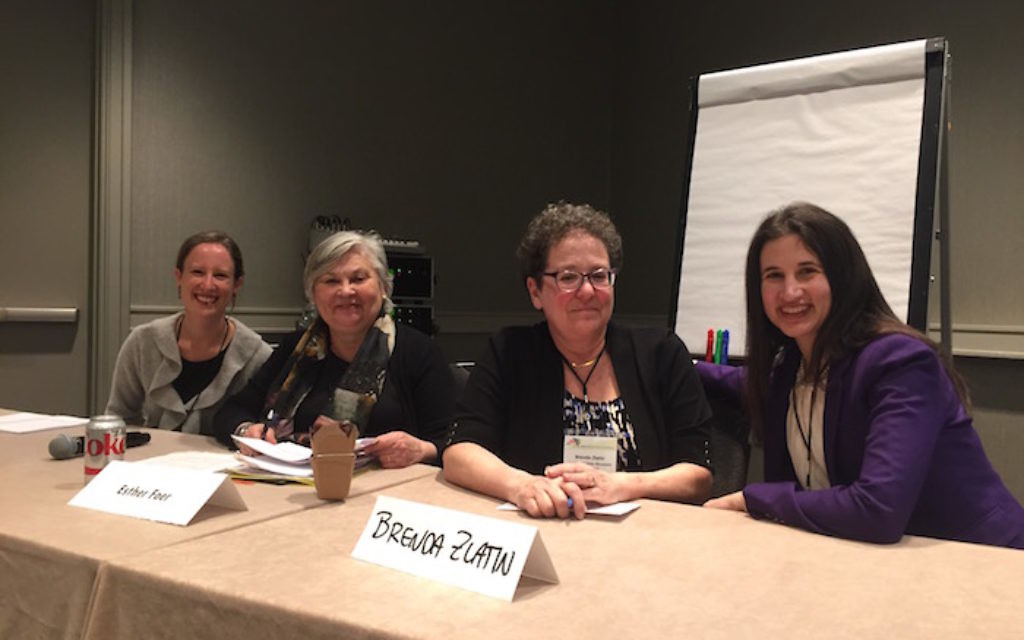Jewish Philanthropy Invests in Future
The principle behind most grant-making initiatives is to achieve a meaningful impact

The relationship between a funder and a grantee is based on trust and support to establish a lasting impact on projects. Finding the right balance can strengthen partnerships, increase capital and create better initiatives based on empathy.
To examine philanthropy within the Jewish community in greater detail, the Jewish Funders Network held a session March 20 on “Better Capital for a Strong Jewish Future.”
The speakers included one local nonprofit leader, Jewish Kids Groups Executive Director Ana Robbins. The others were Esther Foer, former executive director of historic Washington synagogue Sixth & I; Brenda Zlatin, senior program officer of Baltimore’s Blaustein Philanthropic Group; Lesley Matsa, program officer for Chicago’s Crown Family Philanthropies; Aliza Mazor, the executive director of Bikkurim: Advancing New Jewish Ideas; and moderator Jonathan Horowitz, senior program officer of the Boston-based Klarman Family Foundation.
Get The AJT Newsletter by email and never miss our top stories Free Sign Up
“In order to be a good grant maker, individuals need to restrain their ego, whether it’s a project grant or multiyear grant,” Zlatin said. “They really have to think about their role, but even more so when to give general operating support.”
The principle behind most grant-making initiatives is to achieve a meaningful impact with the help of strong organizations. But there are many forms of grants, each with its own criteria.
Unrestricted grants, for example, although not glamorous, fulfill the basic needs of recipients, including operational costs. Such grants, combined with core leaders who are dedicated to a strong work ethic, provide an organization flexibility.
The dynamics of the process have shifted, however, to better address the needs of grantees.
“We have multiyear grants, which include a 40-year agreement,” Matsa said. “This is not typical, but it allows us to establish long-term relationship goals with our grantees, which in turn helps them succeed because they know what the situation is going into the year. … We have a depth of relationship with them, so grantees feel comfortable telling us what challenges they may be facing without feeling vulnerable and trust us to help.”
Long-term grants also have downsides, such as the difficulty in tracking investments in the long run and the need to appeal to young innovators with fresh ideas approaching funders. The longer the term of a grant, the less agile the funding.
“I still think that the pros far outweigh the cons, however,” Matsa said.
Zlatin, however, explained why the Blaustein Philanthropic Group does not make long-term grants. “I think the most important reason why we don’t do it is because social change is not measured in one year. If there is one thing I have learned about measuring outcomes and not just outputs, it is that you just don’t care to say 100 people got this training, but rather what happened as the result of the training is important.”
To further elaborate on the advantages of unrestricted grants former Executive Director, of Washington DC synagogue, Sixth and I, Esther
From the perspective of a grant recipient, unrestricted funding is crucial, Foer said, recounting her experience at Sixth & I. “As a startup, I don’t think we could have achieved anywhere close to the impact if we didn’t have a handful of unconditional, committed donors. … However, you cannot rely on a single donor. In order to make money, you must diversify your dependence on various donors.”
Major donors are important for reaching long-term goals, but the risk, Foer said, is that those big givers won’t want other major funders to encroach on what they created. That attitude can reduce the project’s ability to thrive.
Robbins offered the perspective of a young, entrepreneurial grant recipient.
“When done well, unrestricted funding lends trust and positions funders for a greater impact. It lends legitimacy to an organization and, with the right leaders, allows the programs to expand,” she said.
“I think what both funders and nonprofits are trying to do is to get to good faster … yet the value of nonmonetary support and the relationships I am able to build with funders that take a real interest in the nonprofit are the most beneficial to me because that’s also the place I feel I lend the most value to the funder,” Robbins said.
Robbins also examined the downside of unrestricted funding: “This is usually during the reporting process, where the organization has shifted for various reasons but the funder is unaware. Reporting back to the funder should instead require strategic planning to help gray areas. …
“Sometimes I think about funding as relationship between that of a parent and their child. If you pay two different kids an allowance, one may place a specific amount in their savings, another amount in their tzedakah, and they are very careful with the rest, and the other may immediately spend it on candy. I think the question we need to ask is what type of interaction do funders want with their grantees and how might you leverage your resources to best impact our world.”




comments